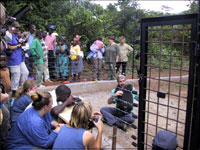HERMOSA BEACH, Calif. (reprinted from gristmagazine.com, art. 4) From a night of tossing and dark dreams, I popped out of bed at 5 a.m. with a mind full of unfinished tasks. Leave no Gestalt undone, or sleep will suffer. Trouble is, there is never closure on the work I do. So I wrap myself in a sarong and stumble in the darkness down the hall to my office. A typical Thursday: pushing the emails out early, lobbing the ball into the other guy’s court before the weekend begins.
It is tough to manage projects on the other side of the world. Impossible, really. I should have been in Cameroon this week, but couldn’t pull it off. So now I have to do the best I can with emails and phone calls, and plan to spend twice the time there when I go in May. Luckily, we have an experienced professional taking on the development of our Conservation Values Education program there. Penny Fraser’s email from Yaounde this morning updated me on our progress, and on some of the problems.
Our partner, Cameroon Wildlife Aid Fund, has made tremendous strides. This week, CWAF held a conference on Environmental Education at the new education facility at the Yaounde Zoo and Wildlife Center. The Cameroon Ministry of Environment and Forests (MINEF) contracted CWAF Director Chris Mitchell to help manage and improve the old Yaounde Zoo some five years ago, and the transformation has been extraordinary. Decrepit, dungeon-like cages have been replaced by fine outdoor enclosures where gorilla, chimpanzee, and drill orphans can regain confidence and health in carefully structured primate social groups. The animals are cared for by local men and women who develop strong bonds with their wards. And now, with the opening of a teaching facility, the understanding and empathy that CWAF staff members are developing for endangered wildlife can be transmitted to thousands of Cameroonians.
That is the main emphasis of our work in Africa: to deepen local people’s feelings for the wildlife around them. We focus on apes and other primates because they are most similar to people: They evoke the sense of kinship that will turn consumers and poachers into protectors of wildlife. The Wildlife Protectors Fund was established at the Gorilla Foundation as a focal point for this effort.
 |
| Koko and Penny share a laugh. Photo: Ron Cohn © 2001 Gorilla Foundation / Koko.org |
Psychologists began to study ape communication decades ago. The breakthrough came with the recognition that great apes use gestures and postures to talk to one another. Could they learn to talk with humans, using sign language? Penny Patterson and Ron Cohn, Roger and Debbie Fouts, Sue Savage and Duane Rumbaugh, and Lynne Miles proved that gorillas, chimpanzees, bonobos, and orangutans could learn hundreds of symbols that allowed them to share their desires, their feelings, and their dreams. Apes named Koko, Washoe, Kanzi, and Chantek became famous for crossing the species barrier and exposing our hominoid kinship.
The stories of these communicating apes are being translated into the languages of the people who live in and around primate habitats. Already we have found that the French version of Koko’s Kitten has created positive attitude changes among the thousands of Africans who have read and discussed the story in our education programs. To learn that a huge gorilla can adopt and cherish a tiny kitten shifts people’s perceptions of these apes from savage beasts to sensitive beings.
We are anxious to publish the story of Michael, and inform Africans of the unforgettable trauma that poaching causes for the families of apes killed for bushmeat. That’s what I was supposed to be working on this morning, until other urgencies took over.
 |
| Gorilla orphans bond with their caregiver. Photo: Tony Rose |
To work in the conservation arena is to live in a relentless cacophony of crises. Not only are forests being cut down and wildlife slaughtered. Not only are ape orphans emerging from the bush on death’s edge far faster than we can find people and funds to recover and rehabilitate them. Not only are consumers tasting their first ape meat before we can ignite in them a deep caring for kindred life. But the devoted conservationists already at work in the field are themselves falling prey to the dangers of working for the wild.
I just called a compatriot in Africa only to discover that he has been airlifted with his wife to Europe and is sitting at her bedside in an intensive care unit. This is the latest in a constant string of tragic challenges. Last month, one of our staff spent a week in a British hospital being treated for parasites brought back from the bush. Last summer, one of our program leaders finally threw in the towel and took his family out of Cameroon to seek an assignment in a safer place. Last spring, a bright young field researcher was killed in an auto accident on a narrow dirt road in the rain forest.
The stress and health risks are formidable. But if it seems tough for expatriate conservationists who leave home to work in the bush, it is far, far worse for the average African. They have nowhere else to go. They must face the downturn of their economy and the upsurge of disease and chaos with no exit.
There are success stories, but they are few and far between, and the triumph is always tenuous. My dear friend Joseph Melloh, who has transformed himself from gorilla hunter to wildlife protector, seems to be hanging in there. I think he is out on an assignment, but I’m not sure where. War zone? Hunting camp? Ebola clinic? I worry about him. It’s too late to call anyone over there who might know how he is. I’ll save that for tomorrow.


